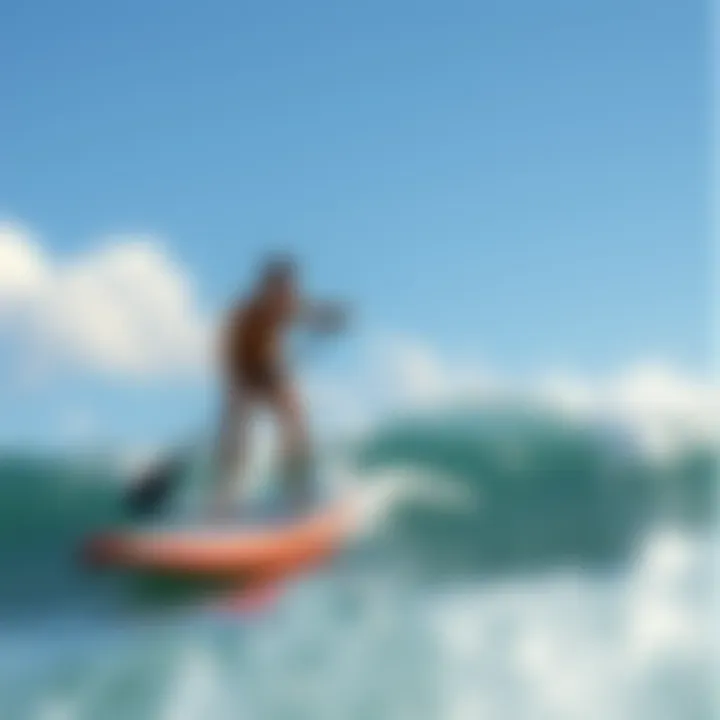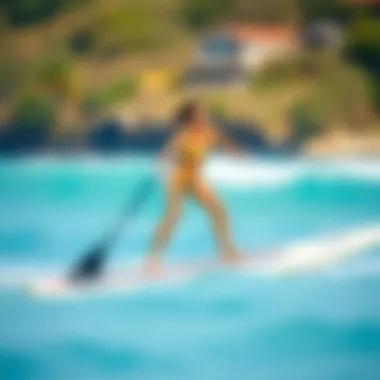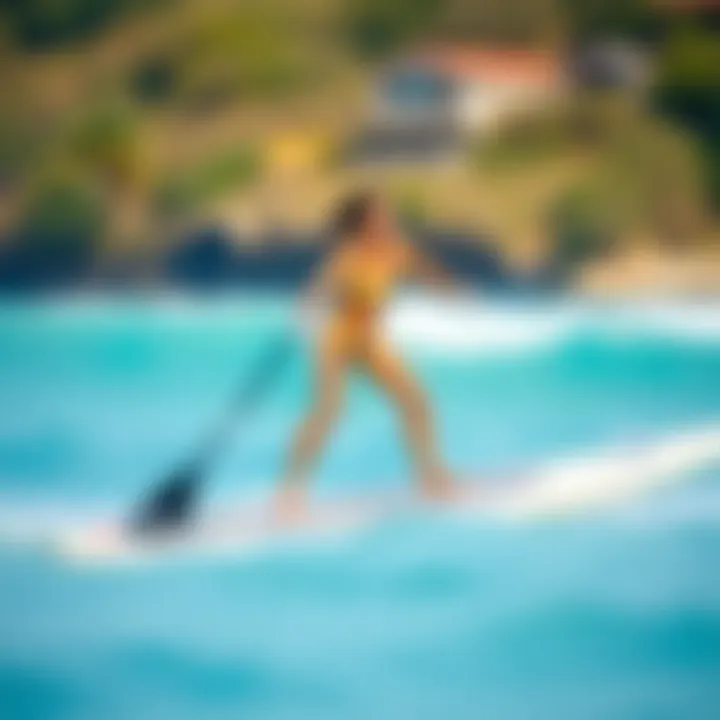Choosing the Right Size for Paddle Boards Effectively


Intro
Choosing the right size paddle board isn't just a quick decision; it’s an essential part of ensuring your time on the water is enjoyable and safe. This article aims to break down the various elements that contribute to an optimal paddle board choice, especially focusing on the interplay between the paddler’s experience, intended usage, and personal physical attributes. Understanding how these elements impact buoyancy and stability is crucial for new and seasoned paddle boarders alike.
Contrary to the notion that bigger always means better in equipment, the right size can be the determining factor for performance, comfort, and overall experience on the water. So stick around as we venture further into the precise considerations for selecting your next board.
Gear and Equipment
Selecting the right paddle board is just one part of the equation; understanding the gear and accessories is equally important. The equipment you choose can enhance or detract from your paddle boarding experience.
Latest Paddle Board Technologies
Recent advancements in paddle board technology have led to lighter, stronger materials and improved designs that accommodate a wider variety of conditions and skill levels. There are boards that now made with drop-stitch construction which makes them lighter while retaining their buoyancy.
Moreover, innovations like inflatable paddle boards are now favored by many for their portability and ease of storage. Brands such as ISLE Surf and SUP and Red Paddle Co. offer inflatable models that combine stability with performance.
The palette of choices continues with different shapes: long boards offer speed, while shorter boards enhance maneuverability. Choosing a board that suits your style is key; if you plan to ride waves, a wider tail provides better control.
Essential Accessories for Every Surfer
When gearing up, do not overlook the accessories that can elevate your paddle boarding adventure. Here’s a rundown of essentials:
- Paddle: Look for an adjustable paddle if you’re uncertain about the board height or share with others. The right length contributes significantly to your stroke efficiency.
- Personal Floatation Device (PFD): This is non-negotiable; safety should always come first, regardless of your skill level. Some states have laws requiring PFDs on boards.
- Leash: A secure leash ensures your board stays tethered to you, especially in tricky waters. An ankle leash is common for most conditions, but for surf, a coiled leash may minimize drag.
- Safety Kit: Having a whistle or flare is smart, especially if you’re venturing into isolated areas.
Ultimately, investing in quality gear can be the difference between a peaceful outing and a turbulent day.
Surf Techniques and Skills
Getting the most out of your paddle board also involves understanding the techniques that can be employed on the board. While equipment is crucial, your personal skill set allows you to fully utilize what you're riding.
Beginner Paddle Boarding Techniques
As a novice, the focus should be on balancing and maintaining stability on the board. Here are crucial tips for beginners:
- Stance: Your feet should be shoulder-width apart, with knees slightly bent. This stance lowers your center of gravity, improving balance.
- Paddling Technique: Hold the paddle with a firm grip, keeping your arms slightly bent. A common mistake is paddling only on one side; alternate strokes to keep going straight.
- Turning: To change direction, use a reverse stroke on the side you're turning towards. This takes practice, but it’s an invaluable technique!
Advanced Maneuvers for Experienced Surfers
For those who have mastered the basics, taking on advanced maneuvers can add excitement. Techniques such as the “cross-bow” stroke or “draw stroke” help in navigating tricky situations. Additionally, learning how to ride waves and understanding the ocean’s patterns will significantly enhance your skillset.
"Practicing consistently and pushing your limits safely can transform your paddle board abilities over time."
Finale
In summary, selecting the optimal size paddle board is more than just picking a number; it involves understanding the symbiotic relationship between your skills, equipment, and environment. With the right board, techniques, and gear, you can maximize your paddle boarding adventures. Whether you are a beginner or an experienced surfer, determining the best fit will ensure you enjoy every moment spent on the water. Resources like Wikipedia and forums on Reddit can provide more user experiences and insights, helping you make well-informed choices.
Intro to Paddle Board Sizing
Choosing the ideal size paddle board is no small potatoes, especially for those venturing into the world of water sports. The right size not only enhances the joy of paddling but can also make or break your experience out on the water. A well-sized board can provide stability, ease of maneuvering, and comfort, while an ill-fitting one might leave you floundering or scrambling to stay upright.
Navigating through various paddle board options without a grasp on sizing can be akin to trying to find your way in a maze blindfolded. Whether you're a seasoned surfer or a curious newbie, understanding paddle board sizing is crucial. This section sets the stage for exploring critical elements such as rider weight, skill level, and intended use, all of which heavily influence your choice.
Understanding Paddle Boards
To really get a hold of paddle board sizing, it’s important to have a basic understanding of what paddle boards are, and the different types available. Paddle boards, or SUPs (stand-up paddleboards), come in various shapes and sizes, each serving distinct purposes. Some are designed for casual paddling on calm lakes, while others are built for racing or surfing in ocean waves.
When looking at paddle boards, it helps to know the differences, for instance, between all-rounder boards, which are versatile and suitable for different conditions, and specialized boards that might cater to particular activities, such as yoga or competitive racing. Having this foundational knowledge will serve you well as you weigh your options in size and dimension.


Importance of Size in Performance
The size of your paddle board can significantly impact its performance. It’s not just a matter of personal preference; it boils down to how the board reacts to your paddling style, the water conditions, and your own physical attributes.
- Stability: A board that is too narrow can feel tippy, while one that's too wide can be cumbersome to paddle effectively. Finding the sweet spot in width based on your weight and height influences how steady you feel while paddling.
- Speed: Length also comes into play. Longer boards generally track better and allow for faster speeds, whereas shorter ones are often easier to maneuver. Depending on your paddling goals, one might suit you better than the other.
- Buoyancy: Lastly, size impacts buoyancy. A larger board can support more weight, making it perfect for heavier paddlers or those who want to bring gear along. More buoyancy means you’ll be less likely to encounter an unplanned dip!
Understanding how these elements work together opens a door to a more enjoyable paddle boarding experience. By grasping the relationship between size and performance, you’ll be better equipped to select a board that aligns with your preferences and goals.
Factors Influencing Board Size
Choosing the right paddle board size is no small feat; an array of factors come into play that can dramatically impact paddling experience and overall performance. Recognizing these aspects is fundamental for both novices and seasoned paddlers alike. Each of these elements—rider weight, height, skill level, and intended usage—provides a different lens through which to evaluate the appropriate size, ensuring a personalized fit that aligns seamlessly with an individual's unique requirements.
The right board size will not just boost your comfort but also enhance stability and maneuverability, turning a potentially frustrating outing into a delightful one. Let's break down each of these influential factors to understand how they contribute to making an informed decision in selecting the ideal paddle board size.
Rider Weight
First and foremost, rider weight plays a crucial role in determining the optimal paddle board size. Heavier paddlers typically require longer and wider boards to achieve the necessary buoyancy and stability. If the board lacks adequate thickness to support the rider's weight, it may sink lower in the water, making it challenging to balance and paddle effectively. Conversely, lighter individuals benefit from boards that are shorter and narrower, enhancing their agility and speed on the water.
Moreover, it's essential to consider how much gear you may be carrying. Additional weight from supplies, such as coolers or sporting equipment, can further influence the choice of board size. Therefore, a careful assessment of both body weight and any extra load is essential to avoid unpleasant surprises out on the water.
Rider Height
Next up, rider height can influence a paddler's leverage on the board. Taller individuals will find it cumbersome and awkward to paddle on smaller boards, as their center of gravity might be too elevated, leading to instability. Conversely, shorter paddlers may struggle with longer boards that make paddle techniques more challenging due to the reach required.
So, finding that sweet spot in length is key. Boards falling within the vicinity of a rider's height can elevate comfort and performance, enabling a more fluid paddling motion. For instance, if you're over six feet tall, a board length of around 12 to 14 feet may serve you well, striking a balance between glide and stability.
Skill Level
Your skill level should not be overlooked in the quest for the right paddle board. Beginners typically benefit from wider, thicker boards, as they provide more stability and are less likely to tip over during use. A novice rider trying to master the art of balance would likely be frustrated on a slender, advanced board tailored for expert paddlers.
As skill level progresses, riders may opt for narrower and longer boards that cater to more advanced paddling techniques. Experienced paddlers can take advantage of fine-tuned shapes and sizes to enhance their performance, increasing speed and reducing drag.
Intended Usage
The intended usage of a paddle board plays an instrumental role in size selection, with different activities requiring distinct characteristics.
Recreational Paddle Boarding
Recreational paddle boarding is often associated with leisurely paddling on calm waters. When engaging in this type of activity, a stable wider board is often preferred. Recreational boards usually feature a user-friendly design, making them ideal for families or casual outings. The leisurely pace means that comfort and ease of use take precedence, ensuring a pleasant experience without the need for high performance.
Racing
On the flip side, for those venturing into competitive realms, racing boards demand a different approach. These boards are designed to be sleek and slender, focusing primarily on speed and efficiency. Their elongated shape reduces water resistance, maximizing performance in races. However, this comes at the expense of stability, which can prove daunting for less experienced paddlers. Choosing a racing board often requires embracing a trade-off between speed and balance.
Yoga and Fitness
Lastly, the rise of yoga and fitness paddle boarding highlights the importance of selecting the right board size for practicing stability and focus. These boards are often wider and thicker, providing a solid platform that isn’t too wobbly. This feature allows participants to move fluidly through poses and stretches on the water. A stable base helps improve balance and is instrumental in enriching the overall practice, making it a popular choice among fitness enthusiasts.
Understanding these factors is essential for achieving the perfect paddle boarding experience. Now, when you step onto the water, whether you're racing through waves or enjoying a serene paddle at sunset, you'll be equipped with the insights necessary to select the right board that complements your style and preferences.
Understanding Dimensions
Selecting the ideal paddle board size encompasses much more than simply picking a model that looks appealing. At the core of this decision lies the fundamental concept of board dimensions, specifically length, width, and thickness. Understanding these dimensions is crucial because they significantly influence how the board performs on the water and how comfortable the rider feels. Each dimension interacts with various elements such as the rider’s weight, skill level, and intended use. Thus, a thorough grasp of these dimensions can lead to a more enjoyable and effective paddle boarding experience.
Length
Short Boards vs. Long Boards


In the world of paddle boarding, length plays a pivotal role in determining ride characteristics. Short boards, typically ranging from 9 to 10 feet, offer greater maneuverability. This is particularly advantageous for those seeking a playful and agile experience, like in rivers or crowded, wind-choppy coastal areas. On the other hand, long boards transcend 10 feet and excel in tracking and straight-line speed, making them favored by touring enthusiasts.
However, a board’s length can also introduce certain challenges. Short boards, while agile, may sacrifice stability, posing a risk for beginners who might find it tricky to balance. Conversely, long boards, while stable, demand more effort to turn quickly. Hence, the choice between short and long boards hinges on individual preferences and intended use, but understanding the nuances is what will enhance one’s paddle boarding performance.
Performance vs. Stability
The trade-off between performance and stability remains an ongoing debate among paddle boarders. Performance generally refers to how well a board glides through the water, particularly relevant in long-distance tours or racing scenarios. A board designed for performance often has sharper contours and is thinner, which can help to slice through the waves effectively.
On the flip side, stability is about the rider’s safety and comfort when navigating choppy waters or when embarking on yoga sessions on the board. Boards engineered for stability are typically wider and boast more buoyant designs. Choosing a board means assessing one's own priorities; do you value swift maneuvering over steadfastness in rough waters? It’s a balancing act, and one’s choice can heavily influence the paddle boarding journey.
Width
Narrow Boards for Speed
Width is another essential dimension affecting paddle board dynamics. Narrow boards, ranging from 28 to 30 inches in width, lend themselves well to speed. The slimmer profile allows for less drag in the water, facilitating faster strokes, which is ideal for racing or long-distance paddling. Narrow boards are often a hit among seasoned paddlers looking to shave seconds off their time while cruising through flat waters.
However, this desire for speed comes with a caveat; a narrower width means less surface area, which could lead to instability, especially for those still finding their footing on the board. For inexperienced riders, skimming over the water at high speed might seem appealing, but it demands precision and balance that can take time to master.
Wider Boards for Stability
In contrast, wider boards typically measure from 30 to 34 inches. This design emphasizes stability over speed, making them more suitable for beginners or those engaging in activities requiring balance, such as yoga or fishing. The increased surface area provides a sense of security, enabling riders to feel less wobbly even in challenging conditions.
While the trade-off for such stability might be a slight decrease in speed, wider boards encourage a more relaxed environment for leisurely paddling or exploring calm lakes. This stability becomes indispensable for families or groups with varying skill levels, ensuring everyone can enjoy the ride without anxiety of a potential fall.
Thickness
Impact on Buoyancy
Thickness holds substantial sway in the discussion of paddle board suitability. Generally, thicker boards offer increased buoyancy, allowing them to float better, which is particularly advantageous for heavier paddlers. The buoyancy helps riders remain above the water rather than sinking, offering a sense of comfort during paddling adventures.
However, the thicker boards can sometimes feel cumbersome during maneuvering due to their size, presenting a challenge for quick movements. Thus, a deeper understanding of how thickness interacts with buoyancy can lead to an informed decision about board selection that factors in both performance and comfort.
Effect on Weight Capacity
Weight capacity is another crucial consideration linked to thickness. A thicker paddle board can often accommodate a higher weight limit, allowing heavier individuals to find a suitable model without sacrificing the quality of their ride. For groups or outings involving additional gear, understanding the interplay between thickness and weight capacity becomes even more imperative.
However, just because a board can support a certain weight doesn’t mean it’s the most suitable choice for all riders. Selecting a board that matches one’s weight and paddling style while keeping thickness in check can lead to an optimal experience on the water. Each individual’s physical characteristics play a significant role when making this choice.
Board Shapes and Their Implications
When choosing a paddle board, the shape of the board plays a crucial role in how it performs on the water. Understanding the nuances of board shapes can significantly influence an individual's experience, whether they are navigating tranquil lakes or riding ocean waves. The shape can affect factors such as speed, stability, and maneuverability. Thus, becoming acquainted with various board shapes equips paddlers to make informed decisions that cater to their specific needs.
Outline Shapes
Displacement Hulls
Displacement hulls are designed primarily for slicing through the water rather than skimming over the surface. This makes them ideal for long-distance paddling and activities where speed is paramount. One of the key characteristics of displacement hulls is their pointed nose, often resembling that of a kayak. This shape allows the board to cut through waves efficiently. What sets displacement hulls apart is their ability to maintain speed with less effort, making them a favored choice among endurance paddlers. However, they can be less stable than other shapes, especially for beginners or those looking for stability in choppy waters.
The main advantage of displacement hulls is their speed; they glide over water with ease and can cover more distance in less time. However, their slender design may cause a steeper learning curve as paddlers need to balance carefully to avoid tipping over.
Planing Hulls
On the flip side, planing hulls are built for stability and quick maneuverability, making them particularly suited for recreational use and surfing. Recognized by their flatter, wider shape, they provide a larger surface area that helps to distribute the weight evenly across the board. This unique structure allows paddlers to ride on top of the water rather than slicing through it.
Planing hulls shine in conditions where speed isn’t the goal. These boards are popular for recreational paddlers and thrill-seekers looking to catch some waves. They are often easier to control in rougher waters, providing more stability for those who may find themselves off balance. However, they typically lack the same high-speed potential that displacement hulls boast, which is a consideration for those looking to maximize their speed on long voyages.
Rocker Profiles


The rocker, or the curve from the nose to the tail of the board, significantly impacts performance in various water conditions. A board with a high rocker is more responsive and works better in waves, while a flatter rocker excels in calm waters and provides straight-line speed. Different paddlers might prefer different rockers based on their paddling style and the conditions in which they find themselves.
Understanding the shapes and rockers of paddle boards gives you the tools to choose the right board suited to your specific needs, enhancing your overall paddle boarding experience.
With an appreciation of outline shapes and their respective hull designs, paddlers are better equipped to select a paddle board that aligns with their preferences and intended use, ultimately enriching their enjoyment of this water sport.
Personal Considerations in Choosing Size
When one is on a quest to find the paddle board that fits them like a glove, personal considerations play a pivotal role. It's not just about reviews or flashy advertisements; it's about how your own body and experience intertwine with the board. After all, no two surfers are alike, and the variables that influence the right size are many. Factors such as physical fitness and past water sports experience shape your ultimate choice.
Physical Fitness and Strength
Understanding your own physical fitness is essential when choosing a paddle board. If you’re the kind of person who hits the gym regularly or enjoys an active lifestyle, you might lean toward a narrower and longer board. These boards are generally faster and give you better glide, but they require a bit more strength and balance to maneuver, especially if you're still finding your sea legs.
On the other hand, if you prefer a more leisurely pace and maybe don’t exercise as often, a wider board with a bit more stability could be your best bet. Wider boards offer a solid platform and can make it easier to stand and paddle, especially for beginners. In the world of paddle boarding, one size doesn’t fit all.
Another aspect to consider is how you plan to use the board. Are you leaning toward fitness paddling or leisurely rides? The choice of board size could either elevate your experience or lead to frustration, depending on your fitness levels. If you're aiming to do some intense workouts on the water, a stable yet responsive board is essential, and might call for a size that fits a more active physique.
Experience with Water Sports
Your past water sports experience is just as crucial as your fitness. If you’re a newbie, you'll likely benefit from a board that offers more stability. That’s where wider and thicker boards come in. They provide a larger surface area, making the experience less daunting as you get used to the feel of gliding through water.
Conversely, if you're an experienced paddle boarder or surfer, your familiarity with balance and control will allow you to experiment more with different shapes and sizes. Advanced paddlers may prefer a board that is longer and narrower, as it allows for speed and nimbleness. This familiarity can drastically enhance your performance on the water, allowing you to enjoy paddling in various conditions.
Having a solid foundation in water sports means you can make more informed choices about board specifications. Being able to identify what you personally need from your paddle board opens the gateway to countless adventures ahead.
Choosing the right size is as much about your personal characteristics as it is about the board itself. So, understanding your fitness and experience level can significantly enhance your paddle boarding journey.
Practical Tips for Selection
When it comes to selecting the perfect paddle board size, practical tips can be your best friend. The right size not only enhances your performance but also your overall enjoyment on the water. It’s about finding that happy medium where comfort meets capability. Thus, understanding some straightforward practices can significantly impact your paddle boarding experience.
From testing various boards to seeking expert advice, these tactics are solid ways to ensure you choose the board that truly fits your needs. By applying these practical tips, you can steer clear of common pitfalls and elevate your time on the water to the next level.
Try Before You Buy
One of the most critical recommendations for selecting a paddle board is to try before you buy. Imagine stepping into a shoe store and simply picking the first pair that catches your eye without trying them on. Sounds illogical, right? The same goes for paddle boards. Each model and size feels different—for instance, a longer board may feel steadier but harder to maneuver, while a shorter board might offer agility but demand more balance.
- Visit a local rental shop. Most coastal areas have shops that allow you to rent boards for a few hours, or even whole days. This can be an excellent opportunity to evaluate how you feel on different sizes.
- Take note of how stable each board feels while you paddle. Pay attention to how your body responds. You want to feel comfortable, not precarious.
- If possible, ask for boards that are similar in shape but vary in size. Subtle differences can have a large impact on performance, especially for specific activities like racing or yoga.
"Testing multiple boards can unveil surprises about your preferences and capabilities that you didn't know before."
Consulting with Experts
When in doubt, reaching out to those who know the game is always a wise move. Consulting with experts can save you plenty of time and help you avoid costly mistakes on your paddle board journey.
- Visit paddle board shops and engage with the staff—they’re usually passionate paddle boarders who can offer insights on what size may suit you best based on their history with different boards.
- Consider attending workshops or paddle board demonstrations. Often, manufacturers will host events where you can meet foundational experts in the paddle board industry. This type of networking can yield invaluable information.
- Seek advice online in forums or from social media groups dedicated to paddle boarding. Places like reddit.com often have members who are eager to share their knowledge.
- If you can, find a local coach or take a lesson. Not only will you learn about proper technique, but they can also recommend what size board you should consider based on your progress and goals.
Epilogue
Choosing the right size for your paddle board is not just a matter of preference but also a critical factor that can dramatically influence your overall experience on the water. Whether you're gliding across a serene lake or battling the waves along the coast, the board's size plays a pivotal role in performance, stability, and enjoyment. In this article, we delved into the nuanced considerations regarding paddle board sizing, emphasizing the importance of personal factors such as rider weight, height, skill level, and intended usage.
Understanding these elements helps in selecting a board that doesn't just fit the physical specs but matches your unique style and purpose on the water. A well-chosen paddle board can enhance your efficiency, allowing you to maximize your time paddling rather than struggling against an ill-suited board. So, it's essential to weigh all factors carefully and potentially experiment with different boards before settling on one.
Ultimately, finding the right size isn't just about comfort; it can also prevent injuries and build confidence for both novice and seasoned paddlers. In summary, arming yourself with the knowledge shared throughout the article will facilitate an informed decision as you embark on your paddle boarding adventure.
Recap of Key Factors
- Rider Weight: Heavier riders generally benefit from wider and thicker boards for better buoyancy.
- Rider Height: Taller paddlers might choose longer boards, while shorter individuals may find smaller sizes more manageable.
- Skill Level: Beginners typically fare better on stable, wider boards, while experienced paddlers may prefer faster, narrower designs.
- Intentions with the Board: Usage varies between recreation, racing, or yoga; each requires a specific board characteristic.
Final Thoughts on Optimal Size
The quest for the ideal paddle board size blends personal preferences with practical considerations. It's less about finding the so-called 'perfect' board and more about aligning your choice with your specific paddling style, frequency of use, and personal abilities. Think of your board as an extension of yourself. Regularly reassess your needs as you grow in skill and broaden your experiences on the water.
To learn more about specific board models and user experiences, visit forums like Reddit or check trusted resources such as Wikipedia on Stand-Up Paddleboarding. The right paddle board is out there waiting for you to take the plunge!







